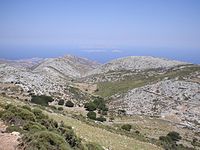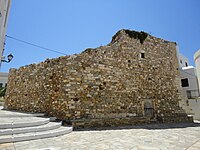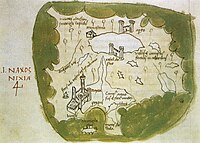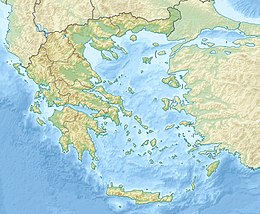Наксос
Родное имя: Наксос | |
|---|---|
 Порт Наксос (город) | |
| Geography | |
| Coordinates | 37°05′15″N 25°24′14″E / 37.08750°N 25.40389°E |
| Archipelago | Cyclades |
| Area | 430 km2 (170 sq mi) |
| Highest elevation | 1,003 m (3291 ft) |
| Highest point | Mt. Zeus |
| Administration | |
Greece | |
| Region | South Aegean |
| Regional unit | Naxos |
| Capital city | Naxos (city) |
| Demographics | |
| Demonym | Naxiot |
| Population | 18,904 (2011) |
| Pop. density | 44/km2 (114/sq mi) |
Naxos ( / ˈ n æ K S ɒ s , - S oʊ s / ; греческий : naxos , Чувство [ˈnaksos] ) - греческий остров и самый большой из велосипеда . Это был центр архаичной цикладической культуры . Остров известен как источник Эмери , рок, богатый корундумом , который до современного времени был одним из лучших доступных абразивов . [ 1 ]
Крупнейшим городом и столицей острова являются Чора или Город Наксос , с 7 374 жителями (перепись 2011 года). Основными деревнями являются Филоти , Апирантос , Вивлос, Агиос Арсениос, Коронос и Глинадо .
История
[ редактировать ]Мифический Наксос
[ редактировать ]

Согласно греческой мифологии , молодой Зевс вырос в пещере на горе Зас (« Zas », что означает « Зевс »). Гомер упоминает « Диа »; Буквально священный остров "Богини". Кароли Керени объясняет:
This name, Dia, which means 'heavenly' or 'divine', was applied to several small craggy islands in our [Aegean] sea, all of them lying close to larger islands, such as Crete or Naxos. The name "Dia" was even transferred to the island of Naxos itself, since it was more widely supposed than any other to have been the nuptial isle of Dionysus.[2]
One legend has it that in the Heroic Age before the Trojan War, Theseus abandoned Ariadne on this island after she helped him kill the Minotaur and escape from the Labyrinth. Dionysus (god of wine, festivities, and the primal energy of life) who was the protector of the island, met Ariadne and fell in love with her. But eventually Ariadne, unable to bear her separation from Theseus, either killed herself (according to the Athenians), or ascended to heaven (as the older versions had it). The Naxos portion of the Ariadne myth is also told in the Richard Strauss opera Ariadne auf Naxos.
The giant brothers Otus and Ephialtes figure in at least two Naxos myths: in one, Artemis bought the abandonment of a siege they laid against the gods, by offering to live on Naxos as Otus's lover; in another, the brothers had actually settled Naxos.
It is also said that the sea god Poseidon was passing by Naxos whilst driving his chariot on the sea surface and is where he first laid eyes on his future wife, the nereid Amphitrite as she was dancing there.

Middle Paleolithic era
[edit]Stelida quarry, south-west of Chora,[3] contains Mousterian tools dating back to the Middle Paleolithic era, which indicates that Neanderthal activity on the island spanned almost 200,000 years ago.[4] The extinct dwarf elephant species Palaeoloxodon lomolinoi lived on Naxos at some point during the Late Pleistocene.[5][6]
Cycladic civilisation
[edit]Zas Cave, inhabited during the Neolithic era, contained objects of stone from Melos and copper objects including a dagger and gold sheet. The presence of gold and other objects within the cave indicated to researchers the status of the inhabitant.[7]
Emery was exported during that time, to other islands.[8]
Classical era and Greco-Persian Wars
[edit]
During the 8th and 7th centuries BC, Naxos dominated commerce in the Cyclades.
Herodotus describes Naxos circa 500 BC as the most prosperous Greek island.[9]
In 499 BC, an unsuccessful attack on Naxos by Persian forces led several prominent men in the Greek cities of Ionia to rebel against the Persian Empire in the Ionian Revolt, and then to the Persian War between Greece and Persia.
Naxos was the first Greek city-state to attempt to leave the Delian League circa 469 BC; Athens quickly quashed the notion and forcibly removed all military naval vessels from the island's control. Athens then demanded all future payments from Naxos in the form of gold rather than military aid.
Byzantine era
[edit]
In Late Antiquity, the island was part of the province of the Islands.[10]
Pope Martin I was detained on the island of Naxos for almost a year after he was arrested by Byzantine authorities in Rome due to his holding of a synod that condemned monotheletism. He was held on the island prior to being taken to Constantinople for trial. While detained on the island, he wrote to a certain Theodore living in Constantinople.[11]
Under the Byzantine Empire, Naxos was part of the thema of the Aegean Sea, which was established in the mid-9th century.
In Byzantine times, the island's capital was on the southern fortress of Apalyres.[12] During this time, it suffered from Saracen raids, particular during the existence of the Emirate of Crete (824–961), to which the island occasionally paid tribute. Traces of Muslim artistic influence are visible in frescoes from the 10th century.[12] Nevertheless, as in Antiquity, Naxos was celebrated for its agriculture and animal husbandry; the 12th-century geographer al-Idrisi records extensive cattle raising on the island.[12]
In the late 12th century, it may have been the capital of a short-lived thema of the "Dodekanesos".[10]
Duchy of Naxos
[edit]


In the aftermath of the Fourth Crusade, with a Latin Empire under the influence of the Venetians established at Constantinople, the Venetian Marco Sanudo conquered Naxos and most of the other Cyclades in 1205–1207.[10] Of all the islands, only on Naxos was there any opposition to Sanudo: a group of Genoese pirates had occupied the castle between the end of Byzantine rule and Sanudo's arrival. To steel his band's resolve, Sanudo burnt his galleys "and bade his companions to conquer or die". The pirates surrendered the castle after a five weeks' siege.[14]
Naxos became the seat of Sanudo's realm, known as the "Duchy of Naxos" or "Duchy of the Archipelago".[10] Twenty-one dukes in two dynasties ruled the Archipelago, until 1566; Venetian rule continued in scattered islands of the Aegean until 1714. Under Venetian rule, the island was called by its Italian name, Nasso.
The Sanudi introduced Western feudal law to the island, based on the Assizes of Romania. However, the native Greek population continued to use Byzantine law for civil matters at least until the late 16th century.[10]
In the 13th century, following the capture of Antalya and Alanya on the southern Anatolian coast by the Seljuk Turks, refugees from these areas settled in Naxos.[12] In the 14th century, the island was once more exposed to raids, this time from the Anatolian Turkish beyliks, chiefly the Aydınids. In turn, the Sanudi assisted the Genoese in capturing Chios in 1304 and the Knights Hospitaller in their conquest of Rhodes in 1309, in order to stop these islands being used as Turkish pirate base. Nevertheless, raids against Naxos are recorded in 1324 and 1326, and in 1341, Umur of Aydın carried off 6,000 people from the island and imposed a payment of tribute. Two years later, however, the Smyrniote crusade captured his main port, Smyrna.[12]

The relief was temporary, however, as Turkish raids recommenced later in the century. The island was so depopulated that Cristoforo Buondelmonti in c. 1420 claimed that there were not enough men to wed the Naxiot women.[12] The rising Ottoman Empire first attacked the island in 1416, but the Sultans recognized Venetian overlordship over the Duchy in successive treaties, in exchange for an annual tribute.[12]
Ottoman era (1566–1821)
[edit]The Ottoman administration remained essentially in the hands of the Venetians; the Porte's concern was satisfied by the returns of taxes. Very few Turks ever settled on Naxos, and Turkish influence on the island was insignificant. Under Ottoman rule the island was known in Turkish as Nakşa. Ottoman sovereignty lasted until 1821, when the islands revolted; Naxos finally became part of the Greek state in 1832.[citation needed]
Early commentators
[edit]Early commentators in English on the island include:[15]
Bernard Randolph, in The Present State of the Islands in the Archipelago (1687, Oxford, pp. 20-21).
Jean de Thévenot, in Travels into the Levant (1687, London, pp. 103–105).
Joseph Pitton de Tournefort, in A Voyage Into the Levant (1718, London, pp. 161–176).
Thomas Bankes et al., in A new royal authentic and complete system of universal geography antient and modern... (1787, London, p. 943).
Edward Daniel Clarke, in Travels in Various Countries (1814, vol. 3, section 2, London, pp. 377–400).
William Martin Leake, in Travels in Northern Greece (1835, vol. 3, London, pp. 93-95).
Theodore Bent, in The Cyclades, or Life Among the Insular Greeks (1885, London, pp. 329–371).
Geography
[edit]Climate
[edit]Naxos experiences both a Mediterranean climate (Csa) and a hot semi-arid climate (Köppen climate classification: BSh) depending on the location. According to the stations of the National Observatory of Athens, various locations in Naxos have a hot semi-arid climate.[16] [17] [18] Inland areas of the island are much wetter and cooler in winter, owing to their higher elevation.
| Climate data for Naxos town (0m) | |||||||||||||
|---|---|---|---|---|---|---|---|---|---|---|---|---|---|
| Month | Jan | Feb | Mar | Apr | May | Jun | Jul | Aug | Sep | Oct | Nov | Dec | Year |
| Record high °C (°F) | 22.2 (72.0) |
22.3 (72.1) |
25.4 (77.7) |
30.5 (86.9) |
33.6 (92.5) |
36.2 (97.2) |
37.4 (99.3) |
34.0 (93.2) |
33.0 (91.4) |
30.8 (87.4) |
28.8 (83.8) |
24.0 (75.2) |
37.4 (99.3) |
| Mean daily maximum °C (°F) | 14.3 (57.7) |
14.4 (57.9) |
15.7 (60.3) |
18.6 (65.5) |
21.9 (71.4) |
25.7 (78.3) |
26.6 (79.9) |
26.2 (79.2) |
24.6 (76.3) |
21.4 (70.5) |
18.6 (65.5) |
15.8 (60.4) |
20.3 (68.5) |
| Daily mean °C (°F) | 12.0 (53.6) |
12.1 (53.8) |
13.3 (55.9) |
16.1 (61.0) |
19.4 (66.9) |
23.2 (73.8) |
24.7 (76.5) |
24.4 (75.9) |
22.6 (72.7) |
19.3 (66.7) |
16.2 (61.2) |
13.7 (56.7) |
18.1 (64.6) |
| Mean daily minimum °C (°F) | 9.3 (48.7) |
9.3 (48.7) |
10.2 (50.4) |
12.5 (54.5) |
15.4 (59.7) |
19.2 (66.6) |
21.7 (71.1) |
21.7 (71.1) |
19.8 (67.6) |
16.6 (61.9) |
13.4 (56.1) |
10.9 (51.6) |
15.0 (59.0) |
| Record low °C (°F) | 0.4 (32.7) |
−1.0 (30.2) |
2.0 (35.6) |
5.1 (41.2) |
7.1 (44.8) |
12.0 (53.6) |
14.8 (58.6) |
13.6 (56.5) |
11.2 (52.2) |
7.2 (45.0) |
4.5 (40.1) |
2.0 (35.6) |
−1.0 (30.2) |
| Average precipitation mm (inches) | 71.3 (2.81) |
58.6 (2.31) |
49.8 (1.96) |
18.4 (0.72) |
9.8 (0.39) |
2.8 (0.11) |
0.6 (0.02) |
2.8 (0.11) |
5.7 (0.22) |
39.3 (1.55) |
47.4 (1.87) |
69.4 (2.73) |
375.9 (14.80) |
| Average precipitation days (≥ 1.0 mm) | 8.4 | 7.7 | 5.7 | 3.1 | 1.4 | 0.5 | 0.1 | 0.1 | 0.6 | 3.0 | 5.0 | 8.6 | 44.2 |
| Average relative humidity (%) | 72.0 | 71.2 | 72.0 | 69.5 | 70.7 | 67.8 | 68.7 | 70.2 | 71.1 | 73.2 | 73.8 | 73.3 | 71.1 |
| Source: NOAA[19] | |||||||||||||
| Climate data for Apeiranthos village (600m) | |||||||||||||
|---|---|---|---|---|---|---|---|---|---|---|---|---|---|
| Month | Jan | Feb | Mar | Apr | May | Jun | Jul | Aug | Sep | Oct | Nov | Dec | Year |
| Mean daily maximum °C (°F) | 9 (48) |
10.2 (50.4) |
13 (55) |
15.4 (59.7) |
21.9 (71.4) |
25.1 (77.2) |
27.9 (82.2) |
28.7 (83.7) |
24.9 (76.8) |
22.5 (72.5) |
16.1 (61.0) |
12.3 (54.1) |
18.9 (66.0) |
| Mean daily minimum °C (°F) | 4.8 (40.6) |
5.9 (42.6) |
7.8 (46.0) |
9.7 (49.5) |
15 (59) |
18.6 (65.5) |
21.1 (70.0) |
21.8 (71.2) |
18.7 (65.7) |
16.3 (61.3) |
11.7 (53.1) |
8.6 (47.5) |
13.3 (56.0) |
| Average precipitation mm (inches) | 208.3 (8.20) |
137.8 (5.43) |
80.3 (3.16) |
77.4 (3.05) |
4.7 (0.19) |
1.1 (0.04) |
19.4 (0.76) |
0.1 (0.00) |
24.2 (0.95) |
60.9 (2.40) |
91.1 (3.59) |
155.9 (6.14) |
861.2 (33.91) |
| Source: http://penteli.meteo.gr/stations/apiranthos/ (2019 - 2020 averages) | |||||||||||||
Economy
[edit]

Historical population
[edit]| Year | Island population | Change |
|---|---|---|
| 1981 | 14,037 | – |
| 1991 | 14,838 | +801/+5.71% |
| 2001 | 18,188 | +3,350/+22.58% |
| 2011 | 18,904 | +716/+3.93% |
Tourism
[edit]Naxos is a popular tourist destination, with several ruins. It has a number of beaches, such as those at Agia Anna, Agios Prokopios, Alikos, Kastraki, Mikri Vigla, Plaka, and Agios Georgios, most of them near Chora. As other cycladic islands, Naxos is considered a windy place perfect for windsurfing, as well as kitesurfing. There are seven sports clubs in the island that offer both of these sports and other water activities.
Agriculture
[edit]Naxos is the most fertile island of the Cyclades. It has a good supply of water in a region where water is usually inadequate. Mount Zeus (1,004 metres or 3,294 feet) is the highest peak in the Cyclades, and tends to trap the clouds, permitting greater rainfall. This has made agriculture an important economic sector with various vegetable and fruit crops as well as cattle breeding, making Naxos the most self-sufficient island in the Cyclades. Naxos is well known within Greece for its "Arseniko Naxou" cheese, potatoes, Kitron (a local lemon-citrus spirit), and Naxian honey (which is largely derived from the nectar of thyme).[20]
Marble
[edit]The quarrying of marble on Naxos began before 550 BCE.[21] Naxian marble was used for the creation of the roof tiles at ancient Olympia and on the Athenian Acropolis,[22] As of 2016, about 5,000 m³ of high value Naxian marble was being exported annually.[23]
Sports
[edit]Notable people
[edit]- Ecumenical Patriarch Anthimus III of Constantinople (1762–1842)
- Ecumenical Patriarch Callinicus III of Constantinople (died 1726)
- Keti Chomata (1946–2010), singer
- Manolis Glezos (1922–2020), rebel, politician, writer
- Giannoulis Fakinos (born 1989), soccer player
- Iakovos Kambanelis (1922–2011), poet, playwright, lyricist and novelist
- Kostas Manolas (born 1991), soccer player
- Stelios Manolas (born 1961), soccer player
- Nikolaos Mykonios, fighter of the Greek War of Independence and officer of the Greek Army
- Iakovos Nafpliotis (1864–1942), cantor
- Nicodemus the Hagiorite (1749–1809), saint
- Giorgos Ninios (born 1959), actor
- Michalis Polytarchou, basketball player, Former Captain of AEK Athens BC
- Petros Protopapadakis (1854–1922), Prime Minister of Greece
Gallery
[edit]-
View through Portara on the peninsula Palátia towards Chora of Naxos
-
Agios Nikolaos on the Grotta of Naxos Town (Chora)
-
Valley between Potamia and Moni, Naxos. View from road from Apeiranthos to Filoti
-
Crispi tower, housing the Byzantine museum
-
Panagia Drosiani church, Moni village
-
The monastery of Faneromeni
-
Chalki, Naxos
-
Agios Isidoros at Atsipapi
-
Kaloxilos, Naxos
-
Vourvouria
-
Presentation of the Lord Catholic church of Naxos
-
Koronos village
-
Panagia Damiotissa, Chalki
-
Filoti village
-
Tower in Filoti
-
Apollonas village
-
Keramoti village
-
Tower in Apeiranthos
-
Hawaii beach, Alykos, Naxos
See also
[edit]- Communities of the Cyclades
- Emery (rock), mined on Naxos
- Kitron
- Moutsouna
Citations
[edit]- ^ https://www.naxos.gr/emery-mines/?lang=en (viewed 01/07/2023).
- ^ Kerenyi, Karl (1951). The Gods of the Greeks. pp. 271–272.
- ^ "Introducing Stelida". stelida.org. Retrieved 17 October 2019.
- ^ Carter, Tristan; Contreras, Daniel A.; Holcomb, Justin; Mihailović, Danica D.; Karkanas, Panagiotis; Guérin, Guillaume; Taffin, Ninon; Athanasoulis, Dimitris; Lahaye, Christelle (16 October 2019). "Earliest occupation of the Central Aegean (Naxos), Greece: Implications for hominin and Homo sapiens' behavior and dispersals". Science Advances. 5 (10): eaax0997. Bibcode:2019SciA....5..997C. doi:10.1126/sciadv.aax0997. PMC 6795523. PMID 31663021.
- ^ Van der Geer, A. A. E.; Lyras, G. A.; Van den Hoek Ostende, L. W.; De Vos, J.; Drinia, H. (2014). "A dwarf elephant and a rock mouse on Naxos (Cyclades, Greece) with a revision of the palaeozoogeography of the Cycladic Islands (Greece) during the Pleistocene". Palaeogeography, Palaeoclimatology, Palaeoecology. 404: 133–144. doi:10.1016/j.palaeo.2014.04.003. hdl:10795/3263.
- ^ Athanassiou, Athanassios; van der Geer, Alexandra A.E.; Lyras, George A. (August 2019). "Pleistocene insular Proboscidea of the Eastern Mediterranean: A review and update". Quaternary Science Reviews. 218: 306–321. Bibcode:2019QSRv..218..306A. doi:10.1016/j.quascirev.2019.06.028. S2CID 199107354.
- ^ P Halstead – Neolithic Society in Greece Continuum International Publishing Group, 1999 Retrieved 4 July 2012 ISBN 1850758247
- ^ M Patton – Islands In Time: Island Sociogeography and Mediterranean Prehistory Psychology Press, 23 July 1996 Retrieved 4 July 2012 ISBN 0415126592
- ^ Herodotus, 5.28,5.31
- ^ Jump up to: a b c d e Gregory, Timothy E. (1991). "Naxos". In Kazhdan, Alexander (ed.). The Oxford Dictionary of Byzantium. Oxford and New York: Oxford University Press. pp. 1444–1445. ISBN 0-19-504652-8.
- ^ Andrew Ekonomou. Byzantine Rome and the Greek Popes. Lexington books, 2007
- ^ Jump up to: a b c d e f g Savvides, A. (1993). "Naḳs̲h̲e". In Bosworth, C. E.; van Donzel, E.; Heinrichs, W. P. & Pellat, Ch. (eds.). The Encyclopaedia of Islam, Second Edition. Volume VII: Mif–Naz. Leiden: E. J. Brill. pp. 939–941. ISBN 978-90-04-09419-2.
- ^ William R. Shepherd, Historical Atlas, 1911
- ^ Miller, William (1908). The Latins in the Levant: A History of Frankish Greece (1204–1566). London: John Murray. p. 43. OCLC 563022439.
- ^ http://www.ucke.de/christian/naxos/Naxos_Old_Travel_Descriptions.pdf (viewed 01/07/2023).
- ^ "Monthly Bulletins". www.meteo.gr.
- ^ "Latest Conditions in Naxos, Cyclades".
- ^ "Latest Conditions in Mikri Vigla of Naxos".
- ^ "Naxos Climate Normals 1961–1990". National Oceanic and Atmospheric Administration. Retrieved 2 March 2015.
- ^ Lisiecki, Chelsea; Foufopoulos, Johannes (2022). "Profits vs. preservation: How can shepherds balance the social and ecological costs of livestock grazing on Naxos?". World Development Perspectives. 26. doi:10.1016/j.wdp.2022.100430.
- ^ "Archaic Period". Εθνικό Αρχαιολογικό Μουσείο. Government of Greece. Retrieved 26 October 2021.
Item #10 in slide show
- ^ Aenne Ohnesorg: Inselionische Marmordächer. de Gruyter, Berlin 1993.
- ^ Trianet: камень и горнодобывающие архивирование 2016-03-04 на The Wayback Machine .
Общие и цитируемые ссылки
[ редактировать ]- Agelarakis, A., «Архаический период на острове Наксос: отчет об исследовании археологической антропологии», Управление по древностям эллинга, архивный отчет , 2005, Наксос.
- Эрнст Кертиус , Наксос. Лекция в научной ассоциации в Берлине в 1846 году, недавно опубликованная Мартином Биастохом , Göttingen, 2012.
Внешние ссылки
[ редактировать ]- Официальный веб -сайт (на немецком, греческом и английском языке)
- Перемещающиеся открытки Наксос
- Муниципалитет наксосов и мелких велосипедов (на греческом)
- Фотографии от Naxos Inclusive Tourist-Infos























